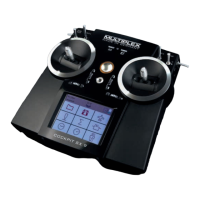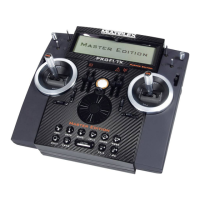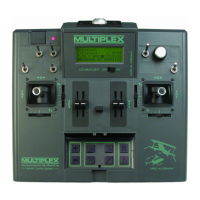Instructions
Page 61
3.2. Range checking
Range checking gives reliable information about the
working condition of your radio control system.
Based on our experience and measurements we have
designed a test formula which will always keep you on
the safe side.
1. Set the transmitter
aerial in an upright,
slightly angled position
and then collapse all
the sections together.
2. Set up the model so
that the tip of the re-
ceiver aerial is about 1
m above the ground.
3. Ensure that there are
no large metallic ob-
jects (e.g. cars, wire
fences etc.) in the vicin-
ity of the model.
4. Carry out the test only
if there are no other
transmitters switched
on - even if they are on
different channels.
5. Switch on the transmitter and receiving system. At
a range of about 80 m between transmitter and
model check that the control surfaces still respond
immediately and definitely to stick deflections,
without carrying out any unwanted movements.
When close to the range limit the servo output
arms will start to jitter; they should not move by
more than the width of the output arm.
6. Secure the model and repeat the test with the
power system running (alternating the throttle set-
ting between idle and full-throttle).
The stated range of 80 m is only an approximate guide-
line, as the actual range will vary very greatly according
to ambient conditions. For example, effective range
may only be half the stated value at a mountain bowl
site, or close to a public radio transmitter, radar station
or similar.
What can you do to establish the cause of insufficient
range?
1. Change the position of the receiver aerial. If it is
close to metal parts or model components rein-
forced with carbon fibre, the receiver may suffer
adverse effects.
The influence of electric power systems and igni-
tion systems also varies if you alter the position of
the aerial.
2. Disconnect the servos from the receiver one by one,
and repeat the check. Connecting leads of exces-
sive length without suppressor filters have an ad-
verse effect on reception conditions. Remember
that servos deteriorate with age, and then generate
more interference than when new (brush sparking,
suppressor capacitors adrift from motor terminals
etc.).
If you are unable to effect an improvement, try remov-
ing the complete system from the model and checking
the equipment on its own. This enables you to deter-
mine whether the fault is in the system, or in the instal-
lation conditions in the model.
Pre-flight checks:
• Charge the transmitter, receiver and flight batteries
carefully, and check their state of charge before and
during the session. This means using the correct
type of charger, and a charge process which is suit-
able for the battery type in use. It also involves
regular care and maintenance of the packs (balanc-
ing by a slow charge), and testing the voltage curve
and capacity.
• At the flying site the first step should always be to
check with the other modellers present whether
your own channel (transmitter frequency) is vacant.
If there is a site manager or flight director present,
register with him and check that you understand
the method of frequency control in use. Do not
switch ON until you have done this, otherwise there
is a danger of channel clashes and wrecked models.
• Check the range with the transmitter aerial col-
lapsed.
• Ensure that you have selected the right model
memory.
• Check that all primary and secondary control sys-
tems are working perfectly, and that the control
surfaces are deflecting in the right “sense” (direc-
tion).
! If you detect any irregularity or problem, abort
the flight. Seek out the cause of the error, elimi-
nate it, then check everything again.
When operating your model:
• If you have little or no experience flying radio-
controlled models, it makes sense to ask an experi-
enced model pilot to help you initially. The use of a
Teacher/Pupil (Trainer) system is strongly recom-
mended, especially for the initial phase of learning
to fly.
• Operate the model only at suitable approved sites.
• Never fly or run your model directly towards or over
spectators.
• Don’t carry out risky manoeuvres when flying or
operating your model.
• Have a clear idea of your abilities and skill; don’t
over-estimate what you can do!
• If you detect any sign of problems or interference,
land the model immediately and carry out a thor-
ough check.
• Caution: static charges!
When the air is extremely dry (in mountainous ter-
rain, in mountain bowls, close to weather fronts)
static charges tend to build up in the transmitter
and/or the pilot. The charge eventually dissipates
through a static spark, which can endanger the pi-
lot or cause interference to the transmitter.
Counter-measures:
When you feel “static”, cease operations as soon as
you possibly can, and walk a little way down the
mountain to reach a less exposed position.

